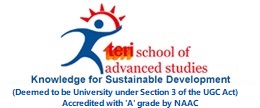
ANNOUNCEMENTS

| Date | News Title | Source |
| 18-July-2025 | 1 in 4 Indian married couples ... | The Indian Express |
| 23-June-2025 | Blended Learning: Driving educ... | The Pioneer |
| 22-June-2025 | All adults overweight in every... | |
| 21-June-2025 | TERI SAS Nurturing Global Sust... | The Interview World (Online) |
| 27-May-2025 | Eco-education trend grows: Sus... | India Today (Online- Education Desk) |
| 25-March-2025 | How water green credits can fu... | Hindustan Times (Opinion) |
| 23-February-2025 | Sustainable biz practices disc... | The Times of India (Online) |
| 21-February-2025 | Sangam fit for bath’, Enviro... | News9 (Online) |
| 12-February-2025 | A role for India in South-Sout... | The Hindu (Online) |
| 02-December-2024 | ICAR Findings Show 34% Decline... | ETV Bharat (Online) |
The Gurugram Metropolitan Development Authority (GMDA) has shelved its plans to concretise four Aravalli creeks lying upstream of Golf Course Road (GCR)
The Gurugram Metropolitan Development Authority (GMDA) has shelved its plans to concretise four Aravalli creeks lying upstream of Golf Course Road (GCR). Spillover from the creeks was identified as one of the major reasons for the unprecedented waterlogging on Golf Course Road last year. The plan to shelve the concretisation was taken at the recommendation of experts from the TERI School of Advanced Studies, who recently conducted a hydrogeological study of the area at the behest of the city-based NGO, IAmGurgaon.
VS Kundu, CEO, GMDA, said, ‘We met with TERI last week and took their recommendation to retain these creeks as kachha (natural) drains. As per our detailed project report for drainage in Gurugram, which is still being executed, these channels were to be concretised as box drains. But since they are natural waterways that can aid in recharging groundwater, they will be left as is and cleaned thoroughly before the next monsoon. This will mitigate the risk of flooding on GCR.”
An interim report produced by TERI in November last year recommended a range of sustainable solutions to conserve rainwater and prevent urban flooding of GCR and neighbouring localities. The measures include building recharge wells along the length of the Wazirabad bundh, establishing green corridors along existing drainage channels and reviving naturally existing catchment areas to hold run-off water during monsoon. TERI’s study, titled Blue Green Interventions for Addressing Flooding Along Golf Course Road and Neighbouring Sectors in Gurugram, was undertaken in the wake of unprecedented waterlogging in Gurugram on August 19, during which GCR was among the worst-affected areas.
A central part of TERI’s study was the assessment of four drainage channels that originate in the Aravallis just above the GCR, and traverse its carriageway before draining into a water body that collects along the nearby Chakkarpur-Wazirabad bundh. The first of these natural creeks, which is also the lowest lying, runs through Sector 26, while the other three are located in sectors 42, 54 and 56. These are classified as creeks 1-4, respectively.
As per the GMDA’s detailed project report for drainage, these creeks were to be concretised and covered. However, in its final report presented to the GMDA last week, researchers at TERI wrote, “It is to be noted that creating box drain drastically reduces the cross section and carrying capacity of the erstwhile channels, and also prevents groundwater recharge. This also adversely affects the natural greenery and biodiversity in the surrounding area of the channels.”
Fauzia Tarannum, of the School of Regional Water Studies, TERI-SAS, said, “Leaving the drains as earthen structures is definitely a sensible step to take. Once cleaned up, they can play a significant role in mitigating flood risks and conserving rainwater in the project area. A large amount of waste and construction debris has been dumped in these creeks, and some restoration work has already begun. It will be important to ensure no further dumping of waste is allowed to take place there.”
TERI’s final report also calls for increased protection of the Aravalli hills located upstream of the GCR. “Gurgaon is highly concretised. This is especially true along the GC Road, where the green belts have been sacrificed for road expansion and the projects along the GC Road have a high level of paved areas which generate higher levels of run-off,” the report states, adding that the Aravalli hills above the GCR are an important groundwater recharge area and a green zone for the city.
“These should be earmarked as a forest and recharge zone where no construction is allowed, as any further construction and concretisation in the Aravallis upstream will increase the storm water run-off and increase the flood risk downstream,” researchers have noted.
Plot No. 10, Institutional Area, Vasant Kunj, New Delhi - 110 070, India.
Tel. +91 11 71800222 (25 lines).
Website : www.terisas.ac.in
Email id : registrar@terisas.ac.in
© Copyright © 2025, TERI SAS, All rights reserved.
Visitors No.: 43484412 Since 2023


